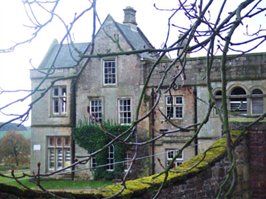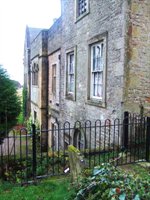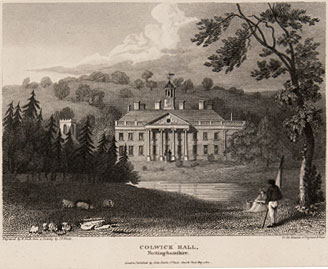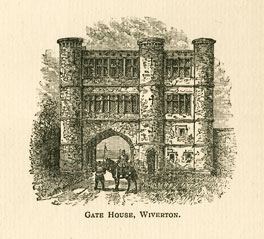Chaworth-Musters family seats
Annesley Hall
Annesley Hall had its origins in a 13th century medieval hall. An aisle post was discovered during restoration of the hall in the 1980s, but no further traces remain. It passed from the ownership of the de Annesley family into that of the Chaworth family by the marriage in 1440 of Sir George Chaworth to Alice de Annesley. The hall was replaced in 1610 by a manor house built for George Chaworth, later 1st Viscount Chaworth. It was extended by the 3rd Viscount Chaworth in the 1660s. The next major building work on the hall did not occur until the 1830s, when Jack Musters replaced the south-east wing. Further renovations were undertaken by Captain Philip Hamond during the minority of John Chaworth Musters between 1849-1859. The work included the demolition of the majority of the old Annesley village close to the hall, the building of a new entrance lodge, and the replacement of the eastern side of the courtyard. In 1865 a major extension to the north side of the hall was completed to designs by Salvin. This part of the building was demolished after Annesley Hall was sold to the Football Association in 1973. The hall was intended as the home of a new football training centre, but this was never opened. It was sold on to various different owners in the late 20th century. In 1998 a portion was destroyed by fire, and in the early years of the 21st century the hall was disused and in poor condition.
![The South East Prospect of Ansley [Annesley] House [Nottinghamshire], by Richard Hall, 1676, published in Thoroton's 'The antiquities of Nottinghamshire'](/ManuscriptsandSpecialCollections/Images-Multimedia/CollectionsInDepth/FamilyandEstate/08-5729pAnnesley.jpg)
The South East Prospect of Ansley [Annesley] House [Nottinghamshire], by Richard Hall, 1676, published in Thoroton's 'The antiquities of Nottinghamshire'


Annesley Hall, 2007
Colwick Hall
Colwick was purchased from the Byron family by Sir John Musters in the mid-17th century. The hall was completely rebuilt in the Palladian style for John Musters in 1775-1776, to designs by the architect John Carr of York (1723-1807). It was damaged by fire in October 1831 after being sacked by rioters enraged at the failure of the Second Reform Bill. It was soon restored, but after the death of Jack Musters in 1849 it was rarely used by members of the Chaworth-Musters family, who preferred Annesley or Wiverton. The contents were sold at auction in 1850 and the house let to tenants. It was sold by John P. Chaworth-Musters to the Nottingham Racehorse Company in 1896. After years of neglect, Colwick Hall was restored and re-opened as a country house hotel and conference centre in 2003.

Colwick Hall, drawn by J.P. Neale, engraved by W. Smith, 1814, published in J. Hodgson and F.C. Laird, 'A Topographical and Historical Description of the County of Nottinghamshire' (London, 1813)
Wiverton Hall
Wiverton was brought into the Chaworth family's possession by the marriage of William de Chaworth (born c.1351) with Alice, daughter of Sir John de Caltoft. William's son Sir Thomas Chaworth obtained a licence to make a park at Wiverton in 1448 and built a castellated mansion there. It was a Cavalier stronghold in the Civil War and used as a garrison for the King's forces. The garrison surrendered to the Parliamentarians in October 1645 and the mansion was destroyed. In 1677 the Nottinghamshire historian Robert Thoroton wrote that 'most of it has been pulled down and removed, except the old uncovered gatehouse, which yet remains a solitary memorial of departed grandeur and ancient hospitality'. In 1814 Jack Musters of Colwick built a Georgian house, in the Gothic style, incorporating the existing gatehouse buildings. In the 19th and early 20th centuries Wiverton was a useful residence for younger sons or widows of the Chaworth-Musters family. It was let out to tenants in 1923, and was sold by John N. Chaworth-Musters, along with its estate of 2,170 acres, in 1938. In 2007 Wiverton Hall was on the property market with an asking price of £2 million.

Wiverton Gatehouse, from Transactions of the Thoroton Society, 1903, p. 133
Edwalton Manor
This mansion house was built in the mid-18th century. George Chaworth's widow Anne lived there with their daughter Mary Ann Chaworth (later Musters) during the period of her widowhood, 1791-1794. The house was sold by John P. Chaworth-Musters soon after he came into possession of his estates in 1887, and was purchased by Thomas Shipstone, the brewer.
West Bridgford Hall
The hall was built between 1768 and 1774 by Mundy Musters of Colwick, Lord of the Manor of West Bridgford. As the Musters family were resident at Colwick, and later at Annesley, it was usually let out to tenants. The hall was sold to Albert Heymann by John P. Chaworth Musters in the late-19th century. It is now the offices of Rushcliffe Borough Council.
Felley Priory
The Augustinian priory was established in 1156 by Ralph Brito, Lord of Annesley. At the Dissolution of the monasteries in 1536 the prior, Christopher Bolton, became the rector of Attenborough church, which had belonged to the priory. The priory buildings were given to William Bollas and his wife Lucy, and passed in 1558 to Sir Anthony Strelley of Strelley with a reversion to Anthony Millington of Nottingham. The Millingtons remained in possession until the early 18th century when the estate was split between two co-heiresses. One share was sold in 1796 by Robert Holden to the representatives of Mary Ann Chaworth. In 1823 her husband Jack Musters bought Miss Catherine Hodgkinson's share of the Felley estate. The Priory buildings were restored by the tenant Mr Cantrell-Hubbersty in the late 19th century. Robert P. Chaworth-Musters moved into Felley Priory in 1960 when his father was still the owner of Annesley, and moved there permanently when Annesley Hall was sold in 1973.
Next page: Biographies